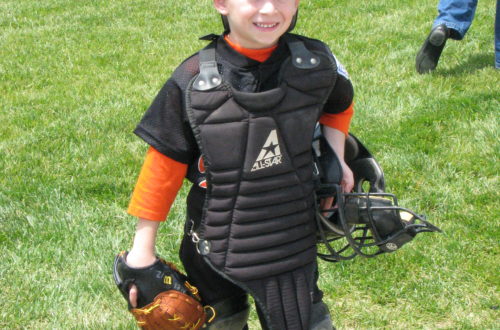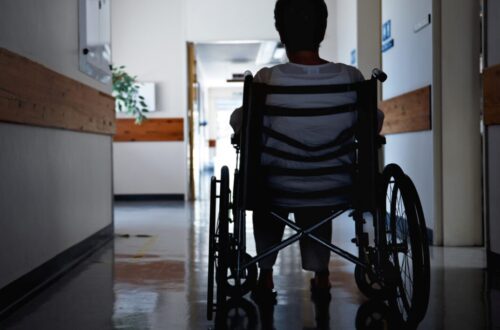A ‘daunting, dark and difficult’ time: How a Brooklyn school moved forward after losing its leader to COVID
Alex Zimmerman, Chalkbeat New York
Mar 12, 2021 7:30am EST
High school student Etienne Musole remembered one of his first interactions with principal Dez-Ann Romain. She asked point blank whether he wanted to graduate. It was a high stakes question at a place like Brooklyn Democracy Academy, an alternative high school in Brownsville serving students who have struggled at traditional schools and are at risk of dropping out.
After the 19-year-old Musole said yes, Romain never let up. “Every day she sees you from that point on, she’s going to be on you,” Musole said.
For many students at the school, Romain was the first educator they felt they could trust, and she deployed a mix of support and tough love. One former student said she counseled him after he broke down in tears over a failed Regents exit exam and let him walk at graduation anyway. (He eventually passed the exam.) Sometimes, she challenged basketball players to pushups if they were goofing around in the hallway instead of heading to class, Musole said.
But just days after city officials shuttered school buildings citywide in March due to surging coronavirus infections, Brooklyn Democracy Academy suffered a devastating blow: Romain was dead. At age 36, she was the first known New York City education department employee to die after contracting the virus.
Her death drew national headlines, as relatively little was known at the time about the coronavirus or who was most at risk. It also plunged a small alternative high school into a series of head-spinning challenges: How to give students and staff space to grieve when they were not physically together. How to quickly transition to virtual learning without the school’s instructional leader. How to keep students, who often struggle with absenteeism in normal times, from slipping through the cracks.
Even more pressing: Brooklyn Democracy Academy had no assistant principal at the time, making it unclear who would step in to help answer these urgent questions. If Romain was the glue holding the school together, it was easy to imagine it could fall apart without her.
“Everything was so uncertain, and I didn’t have any answers,” said social studies teacher Dexter Hannibal. “It was just really scary.” He learned about Romain’s death from a hospital bed during his own debilitating fight with the virus.
In the days leading up to Romain’s death and after students were sent home, teachers were still asked to report to their buildings to prepare for remote instruction, a move that generated pushback from educators across the city. Around the time of Romain’s passing, the principal of another school that shares the building was also hospitalized, though the education department didn’t confirm at the time whether she had the coronavirus
Despite the fear that was coursing through the city, Brooklyn Democracy Academy was perhaps better situated than many schools to weather the crisis. As an alternative “transfer” program that serves students who are older and off track from graduating, the small and close-knit school already prized deep relationships with students to keep them engaged enough to graduate. A small group of “advocate counselors,” for instance, are specifically charged with doing everything from calling students to make sure they come to school to offering support if students are struggling with a crisis of their own.
While some schools may have scrambled to figure out how to keep tabs on students, that wasn’t the case at Brooklyn Democracy Academy. “When we went to remote, it was kind of picking up with what we normally do,” said Lashawn Doyle, the school’s community coordinator and basketball coach.
The immediate responsibility for charting the school’s path forward fell to Yesenia Peralta, an education department administrator who helped oversee transfer schools. She offered to be “the person on call” and then ended up stepping in when Romain became seriously ill.
Her first order of business last spring was making sure the community had space to process, including a vigil, “grieving circles,” and access to counselors, who were also made available to parents. She was especially concerned about her staff’s mental health because she knew if they weren’t emotionally prepared, it would be difficult for them to help students process everything that was happening. Most of all, she didn’t want to “dismantle anything” at the school.
“The students didn’t know me,” she said. “Having that friendly face was the most important thing in that moment.”
In spite of the crisis, she felt compelled to stay on as the school’s interim principal — and has continued in that role this school year.
“We were in a place in a city at that moment that was just so daunting, so dark, and so difficult, and I wanted to do the right thing,” she said. “This community had lost their leader — someone they really loved and respected — and they had gotten to know me, and I didn’t want to abandon them.
It wasn’t just the death of Romain that worried the school’s staff. Students and their families were also dealing with the toll of the virus, which has killed nearly 30,000 city residents. About 80% of Brooklyn Democracy Academy’s students are Black and 17% are Hispanic, populations that have been disproportionately impacted during the pandemic. More than 80% of the school’s students come from low-income families, and some students took on part-time jobs to help make ends meet, teachers said.
At the same time, the crisis disrupted some of the ways the school typically keeps students engaged. Due to uncertainty about how the virus was spreading, counselors eased up on home visits for the next several months, visits that were often used to re-engage students who were having attendance problems. The school’s Adidas-sponsored basketball team, a big draw for some students, was on hold. And staffers also grappled with how to keep college or career planning on the front burner since that’s a crucial piece of keeping students motivated to graduate.
Counselors “were very worried about picking up a phone to talk to a student about applying to college when on the other end was a kid crying because their grandmother died,” said Lucinda Mendez, the director of transfer schools at New Visions for Public Schools, a non-profit that has partnered with Brooklyn Democracy Academy.
But even if imperfect, staffers found workarounds. New Visions supported virtual career events and worked with counselors to continue forging college and career plans while remaining sensitive to students’ emotional needs. The organization helped consolidate the school’s management of student data, including attendance, engagement with digital schoolwork, and even whether students had reliable internet access — information that is often scattered in different places. Each morning, advocate counselors made phone calls to check on students’ academic or mental health needs.
“Our students are used to: If they have an issue, they can just walk into anybody’s office and talk to them,” said Sheena Rue, a program director at the Mission Society, the community organization that provides the school’s advocate counselors. “We had to adjust,” she added, noting that her team relied on everything from video calls to social media to connect with students.
Inside virtual classrooms, teachers also worked to maintain a sense of normalcy, creating space during class to meaningfully connect with students. Peralta has emphasized the importance of deescalating students’ stress levels and developing plans to turn their negative emotions into more positive ones, hopefully inspiring them to complete their work.
“Before I start any lesson, the first five minutes is down time,” said Hannibal, the social studies teacher. “I have a couple of kids who are big anime watchers, so before I start [I’ll ask]: ‘did you watch that new ‘Attack on Titan’ episode? If you can talk about what they enjoy, some other stuff starts to come out.”
If Hannibal gets the sense that a student is overwhelmed, he might adjust their assignments to take some of the pressure off. He noted the school’s constant communication led them to discover one student’s mother was in hospice after a surgery and was not allowed to return home due to the virus — and the student was missing a functional remote learning device.
“We delivered a new computer to him,” Hannibal said. “We’re checking in with him every single day.”
Since the shutdown last spring, teachers across the city have been wrestling with how to shift their lessons into an online environment. That challenge is particularly acute for Shawn Dawkins, who teaches popular hydroponics and aquaponics courses, since the classes involve lots of hands-on work tending to tanks of lettuce, basil, cilantro, and tilapia. The lab got a big boost under Romain, who helped secure funding from the borough president to expand it, an effort to promote urban agriculture and supply fresh produce to the surrounding community.
After the pandemic forced the school building to shut down in March, and canceled plans for a farmers market supplied by the hydroponic garden, Dawkins asked Peralta if he could continue returning to the building once a week to keep the plants and fish alive — a request she granted.
Dawkins uses the lab in some of his remote lessons and even created a backup hydroponic setup at his home in case he was unable to get into the campus for an extended period. The school is now planning to send small hydroponics kits to student’s homes, including seeds of basil, swiss chard and kale.
“That’s not going to make up for the lack of normalcy,” Dawkins said, referring to his efforts to keep the school’s hydroponics lab going. “But maybe that will give a little tiny bit of it.”
New York City high schools opened in October, but shut down less than two months later when rising coronavirus rates triggered a systemwide shutdown. Officials are planning to reopen high schools later this month, though the vast majority of students opted to learn exclusively from home.
There are signs that the city is turning a corner, as vaccine distribution is expanding and Mayor Bill de Blasio has promised a “full” reopening in the fall. But Brooklyn Democracy Academy also faces headwinds.
The school graduated 87 students last spring, almost half of its student population, as some students felt motivated to honor Romain’s legacy by finishing their coursework. Additionally, state officials canceled exit exams that often trip students up.
Meanwhile, far fewer students appeared to be switching into alternative schools. Brooklyn Democracy Academy’s enrollment plummeted by 31% this school year to 122 students, the fourth largest drop of any school in the city, and far higher than the 4% citywide decline, according to a Chalkbeat analysis. Transfer schools, and other campuses in Brownsville, have seen some of the biggest drops across the five boroughs.
Officials said the drop in enrollment at transfer schools could be connected to policies that have given students more time to complete their coursework in their current schools, reducing the need to transfer to schools like Brooklyn Democracy Academy to catch up. Some students may have obligations to care for relatives or pick up jobs to support their families, taking them away from school altogether during the pandemic.
Officials said they expect enrollment to rebound as the pandemic subsides, but the losses could have big implications in the short term, as funding is tied to enrollment and schools can be asked to return funds mid-year. (An education department spokesperson did not answer questions about whether the city is clawing back money from the school’s budget.)
For his part, Musole, the Brooklyn Democracy Academy student, said he’s excited to get back in the building and was overjoyed that his basketball team will be allowed to play this spring and defend last year’s championship season.
He’s aiming to graduate in June, though because the season was postponed, he is nervous about losing out on some opportunities to be noticed by college basketball programs. Yet like some other students, Romain is still echoing in his mind, coaxing him across the finish line.
“I got to finish strong because when she first spoke to me we agreed on one thing: ‘You’re graduating,’” Musole said. “She’s not going to be there to see me do it, but I still gotta get it done.”
Chalkbeat is a nonprofit news site covering educational change in public schools.


